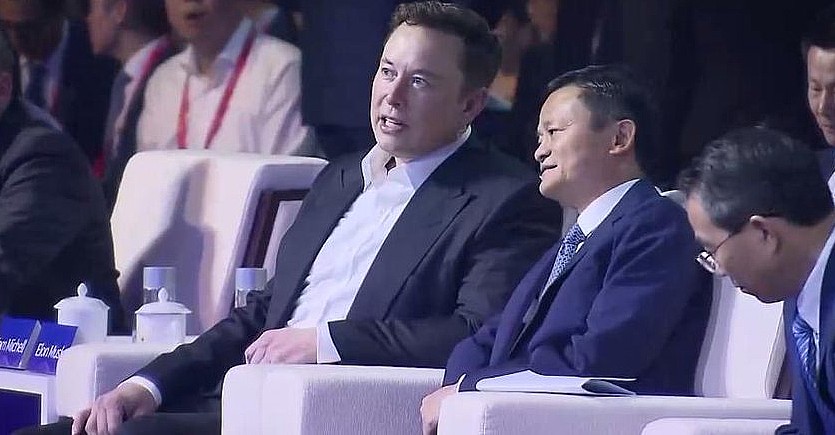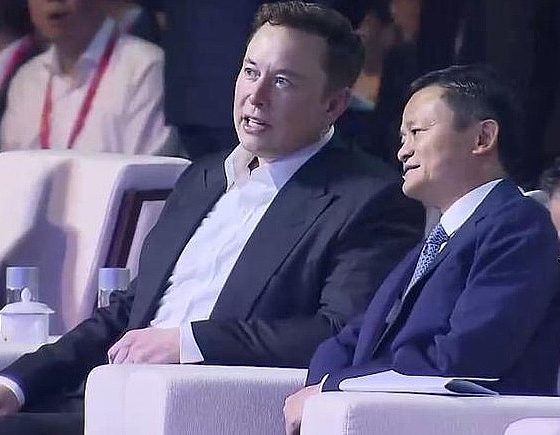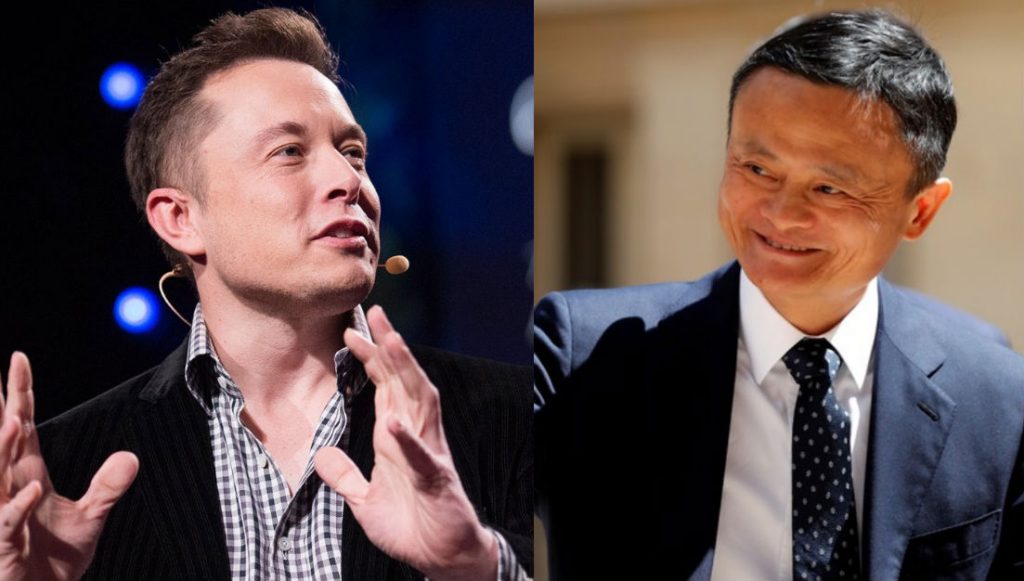

News
Elon Musk and Jack Ma discuss AI’s risks, Mars, and how humans can secure the future
Tesla and SpaceX CEO Elon Musk and Alibaba founder and Chairman Jack Ma kicked off the 2019 World Artificial Intelligence Conference in Shanghai, China, with an informal debate about AI and its implications to humanity. Throughout their conversation, Musk and Ma touched on several topics, from jobs, the need for educational reform, moving to Mars, and how humans’ way of life can improve in the future.
Opposing Views
The two billionaires have vastly differing points of view concerning artificial intelligence. While Musk is cautious about AI considering the dangers it may pose to humanity, Ma is far more optimistic. “I don’t think AI is a threat,” Ma said, responding to the Tesla CEO’s introductory points. Explaining further, the Alibaba founder noted that people are “street smart,” and thus, humanity will be fine even when AI evolves. Musk, for his part, doubled down on his point, arguing that AI’s rate of improvement is notable, and there will come a time when computers will outpace humans’ natural ability to understand it.
Making humans multi-planetary
Musk noted that humans have an opportunity today because this is the first time in history that it’s “possible to extend life beyond Earth.” He added that the window for this could either be open for a long or short time. Thus, it is in humanity’s best interest to secure its multi-planetary opportunities as quickly as possible.
Ma, for his part, argued that he has no interest in multi-planetary initiatives. “I’m not a fan of going to Mars,” he noted. Instead, Ma stated that it’s more pertinent for humans to try and preserve Earth. The Alibaba chairman nevertheless stated that the world needs innovators like Elon Musk, in as much as it needs people who are willing to do what needs to be done to save the planet. “We need heroes like you (who want to go to Mars), but we need heroes like us (who will fix Earth),” Ma said.
Musk explained that preserving Earth is a notable part of Tesla’s mission, from transitioning the transportation sector towards sustainability to fostering energy independence through solar power and batteries. Responding to Ma’s statements about using resources to focus on solving Earth’s problems, Musk noted that it will only take a fraction of the world’s GDP to make humans multi-planetary, comparable or even less than what people spend on something like makeup annually. “Spending resources on making life multi-planetary would be enough with just 1% of the earth’s GDP,” Musk noted.
AI’s threat to jobs
“Why do we need that many jobs anyway?” Ma said, explaining that humans have been fearing that tech will take jobs away for over a hundred years, and yet, jobs have increased. Ma believes that with AI’s help, humans can eventually reach a point where the average workweek is only 3 days per week, and the average workday is only 4 hours a day. This, according to Ma, opens the opportunity for humans to enjoy life more, and live even longer. “We need to be ready to enter the era where everyone will get to live 120 years,” he said.
Musk, for his part, stated that the advent of AI will likely make most jobs pointless. Considering AI’s evolution, Musk noted that the time will come when computers could eventually make their own software. With this in mind, it would be best for people to embrace areas such as engineering and fields of study that deal with human relations, as these will still be pertinent even in the artificial intelligence age. The Tesla CEO added that this is the reason behind Neuralink and its brain-machine interface, as it will prevent humans from being left behind.
The need for education reform
The Alibaba founder admitted that he is worried about the current educational system, which is still largely designed for the industrial period. Ma argues that today, there is a need to foster more creative and constructive education, which would allow humans to live a happier life. “I want to spend more time training kids on painting, singing, dancing, these creative things that make people live like humans,” he said. Ma added that people have heart, and that is where wisdom comes from. With this in mind, it is best for education to focus on training this aspect of the human being.
The Tesla CEO agreed that creative education is needed, particularly as today’s school system is “low bandwidth and extremely slow.” Musk noted that solutions such as Neuralink’s neural lace could be a difference-maker in this sense, as it would allow people to upload skills and learn them quickly, in a manner that is not too far from the concepts depicted in the sci-fi franchise The Matrix.

The dangers of AI
While the two disruptors agreed that there is a need for educational reform, Musk and Ma disagreed most about the potential risks of AI. Ma argued that compared to humans, computers are just a toy, adding that the best resource in the world is the human brain. “It’s impossible that humans could be controlled by machines. They’re machines that are invented by humans,” Ma said.
Musk noted that he very much disagrees with Ma’s stance. Arguing his point, the Tesla CEO stated that humans are capable of creating things that are superior to people. Humans are not the last step in evolution, Musk said, and people must be wary of thinking that they are smarter than they really are. “The most important mistake smart people make is that they think they’re smart. Computers are already smarter than people. We just keep moving the goalposts,” he stated.
Responding to Musk’s argument, Ma noted that the metrics humans use to benchmark themselves against AI (such as world champions in Chess playing against artificial intelligence) do not make sense, as games like Go are designed for human minds. “Why should humans play against computers? It’s stupid to compete with computers,” Ma quipped, adding that while computers can be clever, humans are smarter and wiser.
The future of humanity
Musk believes that one of the world’s greatest threats lie in its declining birthrate. “The world’s biggest issue in 20 years is population collapse,” he said, adding that this could be a big issue considering that humans generally have a “20-year boot sequence.” Ma agreed, stating that even China’s population, which currently stands at 1.4 billion people, sounds a lot today, but if one factors in the country’s declining birthrate, the country will see a completely different landscape in 20 years.
Musk added that more humans are definitely needed, especially with the start of multi-planetary initiatives. “Mars needs people,” he lightly said.
Ma ultimately believes that pursuing AI is wise to make people’s lives better. The Alibaba founded added that artificial intelligence can always do a better job when logic is involved, but when logic is not involved, humans will always be better. To thrive in the future, Ma stated that humans need not just IQ, but emotional intelligence, and (love) intelligence as well. Musk nodded, stating “I agree with him. Love is the answer.”
Watch Elon Musk and Jack Ma’s informal AI debate in the video below.

Elon Musk
Tesla CEO Elon Musk teases insane capabilities of next major FSD update

Tesla CEO Elon Musk teased the insane capabilities of the next major Full Self-Driving update just hours after the company rolled out version 14.2 to owners.
Tesla Full Self-Driving v14.2 had some major improvements from the previous iteration of v14.1.x. We were on v14.1.7, the most advanced configuration of the v14.1 family, before Tesla transitioned us and others to v14.2.
However, Musk has said that the improvements coming in the next major update, which will be v14.3, will be where “the last big piece of the puzzle finally lands.”
14.3 is where the last big piece of the puzzle finally lands
— Elon Musk (@elonmusk) November 21, 2025
There were some major improvements with v14.2, most notably, Tesla seemed to narrow in on the triggers that caused issues with hesitation and brake stabbing in v14.1.x.
One of the most discussed issues with the past rollout was that of brake stabbing, where the vehicle would contemplate proceeding with a route as traffic was coming from other directions.
We experienced it most frequently at intersections, especially four-way stop signs.
Elon Musk hints at when Tesla can fix this FSD complaint with v14
In our review of it yesterday, it was evident that this issue had been resolved, at least to the extent that we had no issues with it in a 62-minute drive, which you can watch here.
Some owners also reported a more relaxed driver monitoring system, which is something Tesla said it was working on as it hopes to allow drivers to text during operation in the coming months. We did not test this, as laws in Pennsylvania prohibit the use of phones at any time due to the new Paul Miller’s Law, which took effect earlier this year.
However, the improvements indicate that Tesla is certainly headed toward a much more sentient FSD experience, so much so that Musk’s language seems to be more indicative of a more relaxed experience in terms of overall supervision from the driver, especially with v14.3.
Musk did not release or discuss a definitive timeline for the release of v14.3, especially as v14.2 just rolled out to Early Access Program (EAP) members yesterday. However, v14.1 rolled out to Tesla owners just a few weeks ago in late 2025. There is the potential that v14.3 could be part of the coming Holiday Update, or potentially in a release of its own before the New Year.
News
Tesla Full Self-Driving v14.2 – Full Review, the Good and the Bad

Tesla rolled out Full Self-Driving version 14.2 yesterday to members of the Early Access Program (EAP). Expectations were high, and Tesla surely delivered.
With the rollout of Tesla FSD v14.2, there were major benchmarks for improvement from the v14.1 suite, which spanned across seven improvements. Our final experience with v14.1 was with v14.1.7, and to be honest, things were good, but it felt like there were a handful of regressions from previous iterations.
While there were improvements in brake stabbing and hesitation, we did experience a few small interventions related to navigation and just overall performance. It was nothing major; there were no critical takeovers that required any major publicity, as they were more or less subjective things that I was not particularly comfortable with. Other drivers might have been more relaxed.
With v14.2 hitting our cars yesterday, there were a handful of things we truly noticed in terms of improvement, most notably the lack of brake stabbing and hesitation, a major complaint with v14.1.x.
However, in a 62-minute drive that was fully recorded, there were a lot of positives, and only one true complaint, which was something we haven’t had issues with in the past.
The Good
Lack of Brake Stabbing and Hesitation
Perhaps the most notable and publicized issue with v14.1.x was the presence of brake stabbing and hesitation. Arriving at intersections was particularly nerve-racking on the previous version simply because of this. At four-way stops, the car would not be assertive enough to take its turn, especially when other vehicles at the same intersection would inch forward or start to move.
This was a major problem.
However, there were no instances of this yesterday on our lengthy drive. It was much more assertive when arriving at these types of scenarios, but was also more patient when FSD knew it was not the car’s turn to proceed.
Can report on v14.2 today there were ZERO instances of break stabbing or hesitation at intersections today
It was a significant improvement from v14.1.x
— TESLARATI (@Teslarati) November 21, 2025
This improvement was the most noticeable throughout the drive, along with fixes in overall smoothness.
Speed Profiles Seem to Be More Reasonable
There were a handful of FSD v14 users who felt as if the loss of a Max Speed setting was a negative. However, these complaints will, in our opinion, begin to subside, especially as things have seemed to be refined quite nicely with v14.2.
Freeway driving is where this is especially noticeable. If it’s traveling too slow, just switch to a faster profile. If it’s too fast, switch to a slower profile. However, the speeds seem to be much more defined with each Speed Profile, which is something that I really find to be a huge advantage. Previously, you could tell the difference in speeds, but not in driving styles. At times, Standard felt a lot like Hurry. Now, you can clearly tell the difference between the two.
It seems as if Tesla made a goal that drivers should be able to tell which Speed Profile is active if it was not shown on the screen. With v14.1.x, this was not necessarily something that could be done. With v14.2, if someone tested me on which Speed Profile was being used, I’m fairly certain I could pick each one.
Better Overall Operation
I felt, at times, especially with v14.1.7, there were some jerky movements. Nothing that was super alarming, but there were times when things just felt a little more finicky than others.
v14.2 feels much smoother overall, with really great decision-making, lane changes that feel second nature, and a great speed of travel. It was a very comfortable ride.
The Bad
Parking
It feels as if there was a slight regression in parking quality, as both times v14.2 pulled into parking spots, I would have felt compelled to adjust manually if I were staying at my destinations. For the sake of testing, at my first destination, I arrived, allowed the car to park, and then left. At the tail-end of testing, I walked inside the store that FSD v14.2 drove me to, so I had to adjust the parking manually.
This was pretty disappointing. Apart from parking at Superchargers, which is always flawless, parking performance is something that needs some attention. The release notes for v14.2. state that parking spot selection and parking quality will improve with future versions.
Any issues with parking on your end? 14.1.7 didn’t have this trouble with parking pic.twitter.com/JPLRO2obUj
— TESLARATI (@Teslarati) November 21, 2025
However, this was truly my only complaint about v14.2.
You can check out our full 62-minute ride-along below:
Elon Musk
SpaceX issues statement on Starship V3 Booster 18 anomaly
The incident unfolded during gas-system pressure testing at the company’s Massey facility in Starbase, Texas.

SpaceX has issued an initial statement about Starship Booster 18’s anomaly early Friday. The incident unfolded during gas-system pressure testing at the company’s Massey facility in Starbase, Texas.
SpaceX’s initial comment
As per SpaceX in a post on its official account on social media platform X, Booster 18 was undergoing gas system pressure tests when the anomaly happened. Despite the nature of the incident, the company emphasized that no propellant was loaded, no engines were installed, and personnel were kept at a safe distance from the booster, resulting in zero injuries.
“Booster 18 suffered an anomaly during gas system pressure testing that we were conducting in advance of structural proof testing. No propellant was on the vehicle, and engines were not yet installed. The teams need time to investigate before we are confident of the cause. No one was injured as we maintain a safe distance for personnel during this type of testing. The site remains clear and we are working plans to safely reenter the site,” SpaceX wrote in its post on X.
Incident and aftermath
Livestream footage from LabPadre showed Booster 18’s lower half crumpling around the liquid oxygen tank area at approximately 4:04 a.m. CT. Subsequent images posted by on-site observers revealed extensive deformation across the booster’s lower structure. Needless to say, spaceflight observers have noted that Booster 18 would likely be a complete loss due to its anomaly.
Booster 18 had rolled out only a day earlier and was one of the first vehicles in the Starship V3 program. The V3 series incorporates structural reinforcements and reliability upgrades intended to prepare Starship for rapid-reuse testing and eventual tower-catch operations. Elon Musk has been optimistic about Starship V3, previously noting on X that the spacecraft might be able to complete initial missions to Mars.








